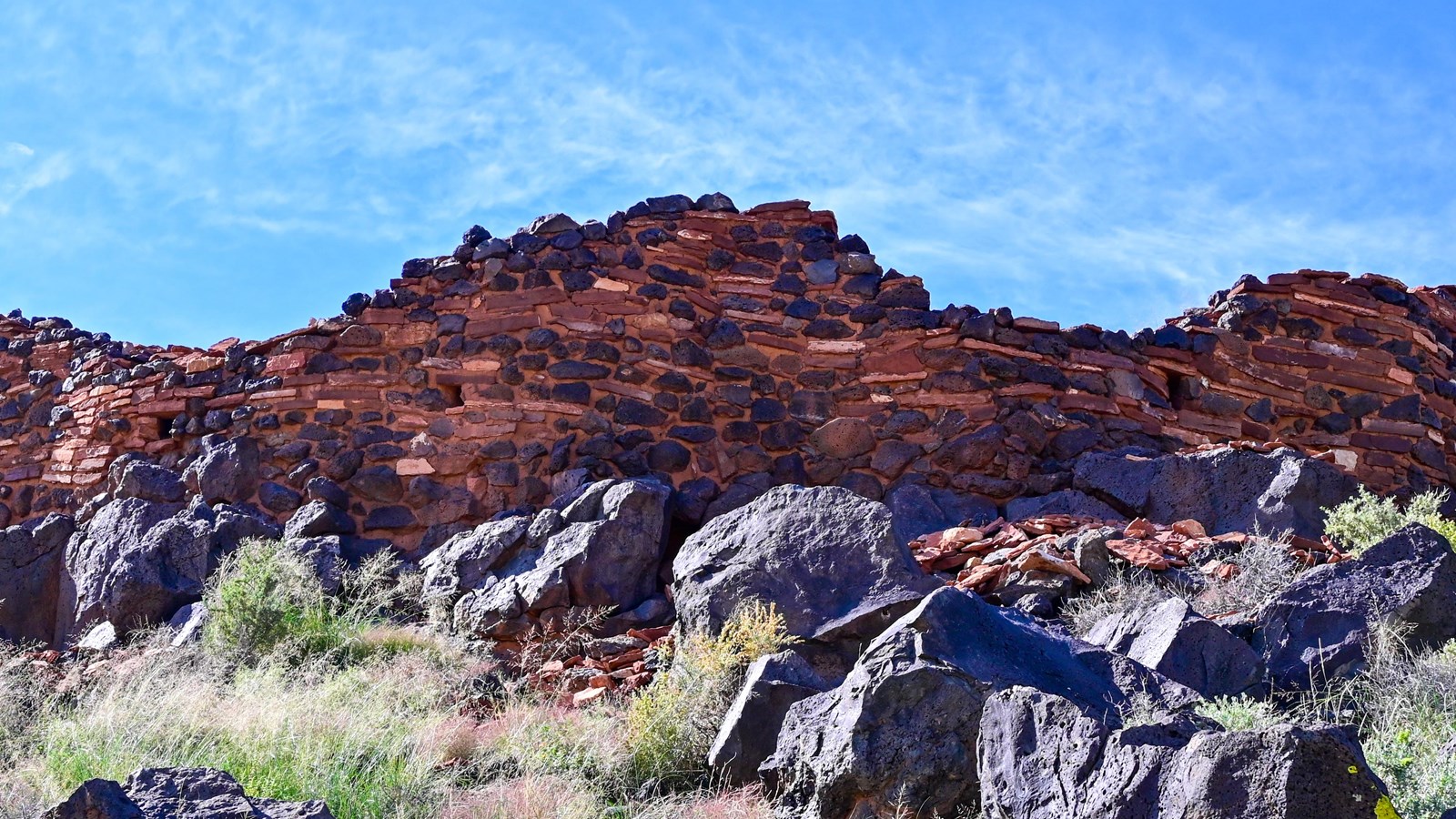Last updated: October 10, 2024
Place
Citadel and Nalakihu Pueblos

Historical/Interpretive Information/Exhibits, Parking - Auto, Parking - Bus/RV, Trailhead
The Citadel and Nalakihu Trail
This trail is a 4 mile (6.4 km) drive from the northern entrance off Highway 89, or a 10 mile (16 km) drive from the Visitor Center. It offers an intimate experience with an an ancestral site and expansive views of the surrounding San Francisco Peaks and volcanic field. The trail is accessible to the base of the cinder hill with a compacted decomposed granite surface. The parking lot is parallel to the road with an entrance/exit on both sides. There are 7 single car spaces, 2 accessible spaces, and 5 oversize vehicle spaces available. Pets are not allowed on this trail; leashed service animals are ok.
Cultural and Historical Importance
The pueblo settlements in Wupatki appear to follow a particular pattern of development. Small family structures with few rooms surround larger community pueblos with many rooms such as Wupatki and Citadel. It is because of this pattern that archeologists refer to different communities within the Wupatki basin which may have been settled by different clans or family groups and may have had somewhat different cultural and religious habits. There is evidence that people have lived in the Citadel area as far back as the Archaic period (8,000 - 500 BCE) using smaller sites as seasonal hunting camps.
By the time Citadel and Nalakihu were constructed in the early 1100s, the community was a thriving agricultural society with trade reaching in all directions for hundreds of miles. Evidence of the mixture of cultural influences can be seen in the ceramic wares found in the area as well as the exisence of different types of human burials, including one cremation which is a tradition from the Hohokam people to the south.
Nalakihu is a Hopi word meaning "house standing outside the village" and is the smaller sandstone structure at the beginning of the trail. Based on tree ring dating construction likely occurred in the late 1190s CE. It had ten rooms on the ground floor and three or four rooms forming a second story. It is difficult to tell how many people would have lived here though it could have been one family with multiple generations and aunts and uncles living together at the same time.
Citadel Pubelo sits atop a small cinder hill and can be seen by any of the surrounding smaller pueblos such as Lomaki and Box Canyon. The walls were built to follow the outline of the hill and constructed with both sandstone and basalt (volcanic rocks).There are hundreds of smaller pueblo structures (1 - 20 rooms) surrounding Citadel as well as traces of agricultural fields, terraces, rock alignments, water catchments, and check dams. Soil samples from around these sites revealed pollen and seeds from domesticated plants such as corn, squash, beans, tobacco, and even cotton.
Although it is no longer physically occupied, Hopi believe the people who lived and died here remain as spiritual guardians. Stories of Wupatki are passed on among Hopi, Zuni, Navajo, and perhaps other tribes. Members of the Hopi Bear, Sand, Lizard, Rattlesnake, Water, Snow, and Katsina Clans return periodically to enrich their personal understanding of their clan history. These places are remembered and cared for, not abandoned. Thank you for helping us protect this important heritage site by not climbing on walls, leaving all natural and cultural items in their place, and staying on designated trails.
Preservation
Citadel Pueblo has never been excavated, though many of the existing walls have been stabilized over the years. Current preservation involves annual stabilization of walls, condition monitoring of both the pueblo structure and the surrounding hillsides, invasive plant removal, and trail maintenance.
In 1933 archeologists excavated, recorded, and reconstructed Nalakihu. Although common in the 1930s, reconstruction involved a lot of guesswork and often destroyed details of the original construction. Between 1933 and 1953, Nalakihu was used as the monument headquarters and contact station, and a WPA (Works Progress Administration) camp was also built at this site to house workers. In 1953, the roof was removed and the reconstructed walls were taken down leaving the remaining original walls at the level to which they existed when they were uncovered by excavation.
